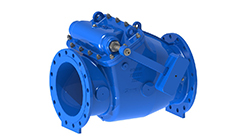.png)
Non-slam check valves have been designed mainly to be used in cases of water hammer. These valves can close without slamming as their name suggests, which means that there are no excess pressure spikes are created. The disc of a non-slam check valve comes with an internal spring which opposes the opening fluid flow pressure. When the flow of a media is enough strong, the spring compresses and the valve gets opened, the disc is pushed back smoothly towards the seating surface in the valve by the spring as the flow stops and decreases, but before flow direction is reversed. Instead of relying on gravity or flow reversal, Non-slam check valves are closed by a spring. With the slowing down of the forward velocity of the fluid, the spring closes down the valve. The closing disc needs to travel a much shorter distance in comparison to a swing check valve and the valve is closed much before the fluid gets a chance for reversing and causing water hammer. This results in minimized and even eliminated effects of water hammer. They are available in a wide range of sizes and configurations including compact dimensions for limited spaces along with multiple pressure classes and material construction.
Features
- Resilient Seating System
- Metal Seating System
- Disc Pivot Action
- V-Packing Shaft Seal System - POP™ (Packing Overload Protection) Shims
- O-ring Cartridge Shaft Seal System
- Integral Mounting Pads- Standard on 3" and larger
- SCADA Compatible Limit Switch Available
Specifications
1 Scope
1.1 This specification covers the design, manufacture, and testing of 2 in. (50 mm) through 48 in. (1200 mm) Swing Check Valves suitable for cold working pressures of 250 psig.
1.2 The Swing Check Valve shall be of the full waterway body type, with a domed access cover and vent port.
1.3 The check valve shall be capable of accepting air cushion, lever and weight or lever and spring
2 Standards, Approvals and Verification
2.1 The valves shall be designed, manufactured and tested in accordance with American Water Works Association Standard ANSI/AWWA C508 and in accordance with Manufacturers Standardization Society Standard Practice MSS SP-71 or MSS SP-136.
2.2 The valves used in potable water service shall be certified to NSF/ANSI 61, Drinking Water System Components - Health Effects, and certified to be Lead-Free in accordance with NSF/ANSI 372.
2.3 Manufacturer shall have a quality management system that is certified to ISO 9001 by an accredited, certifying body.
3 Connections
3.1 The Valves shall be provided with flanges drilled in accordance with ASME B16.1, Class 125 iron flanges or ASME B16.42, Class 150 for ductile iron flanges.
4 Materials
4.1 The valve body, cover and disc shall be constructed of ASTM A536 Grade 65-45-12 ductile iron for sizes 2 in. (50 mm) through 24 in. (600 mm) and ASTM A126 class B, gray iron for sizes 30 in. (800 mm) through 48 in. (1200 mm), with optional body material ASTM A536 Grade 65-45-12 ductile iron. 4.2 The exterior and interior of the valve shall be coated with an NSF/ANSI 61 approved fusion bonded epoxy coating.
4.3 The removable body seat shall be constructed of ASTM A276, Type 304 stainless steel.
4.4 The removable resilient seat shall be precision molded Buna-N (NBR), ASTM D2000-BG. When specified, optional seat material includes EPDM.
4.5 The disc arm and external levers shall be ductile iron.

